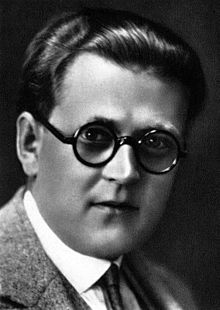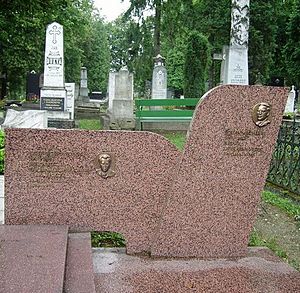Jozef Cíger-Hronský facts for kids
Quick facts for kids
Jozef Cíger-Hronský
|
|
|---|---|

Jozef Cíger-Hronský
|
|
| Born |
Jozef Cíger
23 February 1896 Zvolen, Austria-Hungary (now Slovakia)
|
| Died | 13 July 1960 (aged 64) |
| Resting place | National Cemetery in Martin |
| Occupation | Writer |
Jozef Cíger-Hronský (whose original name was Jozef Cíger) was a famous Slovak writer, teacher, and publicist. He was born on February 23, 1896, in Zvolen, which is now part of Slovakia. He passed away on July 13, 1960, in Luján, Argentina. He is well-known for his many books, especially those for children. He also worked as a secretary and manager for an important Slovak cultural organization called Matica slovenská.
Contents
Life of Jozef Cíger-Hronský
Jozef Cíger-Hronský was born in 1896 in Zvolen. His family were carpenters. He went to school in Zvolen and Krupina. He finished his teaching studies in Levice in 1914.
After his studies, he worked as a teacher in different places. From 1917 to 1918, he was a soldier. He fought on the Italian Front during World War I.
His first stories were published in the 1920s. Besides teaching, he was also an editor. He worked for a children's magazine called Slniečko (which means Little Sun) from 1928 to 1945.
In 1933, he became a secretary for the Matica slovenská. This is a very important Slovak cultural and scientific organization. Later, in 1940, he became its manager. He stayed in this role until 1945.
After World War II, he left Slovakia. He was worried about what might happen to him. He traveled through Austria and Italy. Finally, he settled in Argentina. There, he worked as a designer in a textile factory.
Even in Argentina, he continued to support Slovak culture. He helped create the Matica slovenská Abroad. He also led the Slovak National Council abroad. He was an honorary chairman of the Association of Slovak Writers and Artists Abroad.
Jozef Cíger-Hronský died in 1960 in Luján, Argentina. Many years later, after the Velvet Revolution in 1989, his remains were brought back to Czechoslovakia. In 1993, he was reburied at the National Cemetery in Martin in Slovakia.
Works of Jozef Cíger-Hronský
Hronský wrote in a realistic style. This means his stories often showed life as it truly was. He also had some influence from Expressionism, which is an art style that shows feelings and emotions.
Popular Prose Works
- U nás (1923) - A short story meaning "At Our Home."
- Domov (1925) - A collection of short stories called "Home."
- Žltý dom v Klokočove (1927) - A novel, "A Yellow House in Klokočov."
- Chlieb (1932) - A novel titled "Bread."
- Jozef Mak (1933) - A famous novel that has been translated into English.
- Pisár Gráč (1940) - A novel, "Gráč the Scrivener."
- Andreas Búr Majster (1948) - A novel, "Andreas Búr the Master."
- Svet na trasovisku (1960) - A novel about the Slovak National Uprising, meaning "The World on Quagmire."
Drama (Comedies)
- Firma Moor (1926) - "Moor Company."
- Červený trojuholník (1929) - "A Red Triangle."
- Návrat (1929) - "Comeback."
Children's Literature
Jozef Cíger-Hronský wrote many beloved books for children. Here are some of his well-known titles:
- Najmladší Závodský (1924) - "The Youngest Závodský."
- Kremnické povesti (1925) - "Tales of Kremnica."
- Smelý Zajko (1930) - "Courageous Hare."
- Smelý Zajko v Afrike (1931) - "Courageous Hare in Africa."
- Budkáčik a Dubkáčik (1932)
- Sokoliar Tomáš (1932) - "Thomas the Falconer."
- Zlatý dážď (1933) - "Golden Rain."
- Zlaté hodinky (1934) - "Golden Watch."
- Tri múdre kozliatka (1940) - "Three Clever Little Goats."
- Traja bratia (1941) - "Three Brothers."


